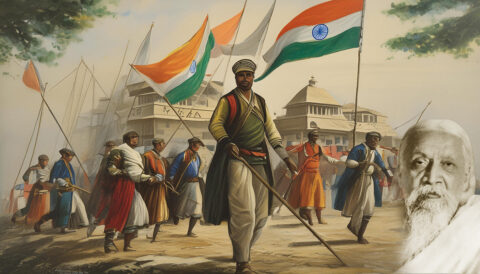Sage and revolutionary – Aurobindo Ghose was a devotee of Swami Vivekananda and inspired by his thoughts, remained engrossed in spirituality on the one hand and walked on the fire path of freedom fight against the British.
Between 1905-06, the Swadeshi and Boycott movements against the Partition of Bengal developed throughout India. The boycott movement gradually began to take the form of a movement for self-realization. At the same time, Aurobindo Ghosh moved to Kolkata from Baroda. He served as the Vice-Principal of Raj College, Baroda. His salary at that time was 1500 rupees (fifteen hundred). Abandoning such a high-paying job, he came to Kolkata and took a job as the principal of the National College at a much lower salary. Here his salary was only 150 rupees (one hundred and fifty). The main reason behind this was that it was very difficult for him to run the revolutionary party from Baroda. The revolutionary work could not be done in time by coming and going to Kolkata again and again. Aurobindo Ghosh could not accept the British imperial rule in the heart of the motherland. Therefore, he moved to Kolkata to overthrow the British regime by conducting and organizing revolutionary activities as per convenience.
Aurobindo Ghosh was born on 15 August 1872 in Kolkata. His father was Krishnadhan Ghosh and maternal grandfather was Rajnarayan Bose. As a child, Ghosh studied at St. Paul’s School. He completed his primary and secondary education from St. Paul’s. He then went to England to study. He studied at the University of Cambridge. He excelled in his results. Despite doing well in all his ICS exams, he could not do well in one exam and hence cannot complete the ICS. From the tender age of fourteen, he thought about the country’s independence and by the time he reached the age of eighteen, he was convinced that India’s freedom from the shackles of British slavery had to be achieved through revolution.
As a student, he was inspired by the French Revolution. Danton and Robespierre, leaders of the French Revolution, had a profound influence on his life. He realized that the independence of the country could not be achieved through petitions, the independence of the country must be achieved through revolution. During his stay in England, he became attracted to the revolutionary secret societies.
In 1901, Aurobindo Ghosh married 15-year-old Mrinalini Devi, a ninth-grade student of the Brahmo Vidyalaya in Kolkata, according to Hindu scriptures. They were married for about 17 years. In her 17 years of marriage, Mrinalini Devi found her husband in a very short time. Aurobindo’s wife Mrinalini Devi kept in touch with him through correspondence as he was mostly busy with the country’s affairs.
He didn’t know where he was working in the country. His wife Mrinalini Devi used to be mentally disturbed at times as she could not get close to her husband. “Aurobindo Ghosh clarified her position in a letter, writing,” “Let me repeat, you are not a common man’s wife, you need special patience and strength.” There may come a time when I will not get any news, not for a month or a month and a half, even for six months. We have to learn to be a little stronger from now on, otherwise we will suffer a lot in the future. ‘
Barindra Kumar Ghosh came to Kolkata from London in 1902. When he came to Kolkata, he started spreading the message of anti-British rebellion. But the people did not respond at all. Unsuccessful, he went to his elder brother Aurobindo Ghosh in Baroda. Barindra Kumar Ghosh, sitting in Baroda, realized that unless politics is integrated with religion, only political movement will not work. Therefore, he planned an exercise committee to give lessons in politics along with the Gita and waited for the right time.
Later, the Ashram for Revolutionary Sannyasins was formed at 32, Muraripukur, Kolkata under the leadership of Barindra Kumar Ghosh. The garden house at 32 Muraripukur Road was the ancestral property of Barindra Kumar Ghosh. Armed revolutionary leader Barindra Kumar Ghosh had built his party’s arena in the garden of Muraripukur. In the middle of the garden there was a small garden. All around the house were trees. Aurobindo Ghosh and two other brothers, Monomohan Ghosh and Binoy Ghosh, lived in the garden. In consultation with Aurobindo, revolutionaries like Barindra Kumar Ghosh, Ullaskar Dutta, Upendranath Banerjee, Hemchandra Ghosh, Avinash Bhattacharya used to decide the policies of the party. Once upon a time, the garden of 32 Muraripukur became the main center of armed revolutionaries.
The years 1903 to 1905 were the chapter of propagating the message of revolution in Bangladesh. Newspapers like Sandhya, Vande Mataram and Jugantar were published during this period. Under the supervision of Sakharam Ganesh Deuskar, P. Mitra and Jatin Bandyopadhyay, the teaching sessions of the revolutionary youth on various theoretical and practical aspects of the revolutionary uprising continued.
In 1903 Pramatha Mitra and Chittaranjan Das established ‘Anushilan Samiti’ in Kolkata. Pramatha Mitra came to Dhaka with Bipin Chandra Pal in 1905 and established a branch of the Anushilan Samiti and Pulin Bihari Das took charge of the Dhaka Anushilan Samiti. The headquarters of the organization was in Dhaka. Many patriotic youth joined this revolutionary practice group inspired by the mantra of freedom. The members of the group started learning to play sticks, knives and fire weapons to hit the chest of the foreign ruler. Around 1906, the second group of revolutionaries, the Jugantor Samiti, was born in Calcutta. Aurobindo Ghosh and Barindra Ghosh took charge of the Jugantor Samiti.
Lord Curzon’s plan for the partition of Bengal in 1905 shook the whole of Bengal. Angry Bengalis took up the banner of revolt and marched towards the movement. In 1906, Aurobindo Ghosh came to Bangladesh and started a campaign to initiate the people of Bengal into the mantra of revolution. During this time, his fiery speeches in Baruipur and Uttarpara have become history. His sister Nivedita also helped the revolutionary youth. A writing of 1906 can be cited as an example of the propagandistic trend of the revolutionaries at this time. After the brutal repression of the British rulers in Barisal in 1906, Jugantor, the mouthpiece of the revolutionaries of Bengal, openly wrote in an editorial on April 26: If the 300 million people of the country raise their 600 million hands in the pledge of resistance, then this oppression will stop. Only power can stop the manifestation of energy. “
The youth of Bengal woke up to protest against the atrocities of the British rulers. Wherever they see the atrocities of the British, they are protesting. They are being persecuted for this protest. Protests against the violence spread to other parts of Bengal. In order to give an organized form to this movement, the youth who were initiated into the revolutionary mantra of Aurobindo Ghosh got united. As the oppression of the British rulers increased, the issue of armed revolutionary uprising in Bangladesh became more acute. The revolutionaries tried to set up bomb-making centres at Jhamapukur and Maniktala. This secret organization of the revolution gradually spread to Midnapore, Chandannagar, Krishnanagar, Srihatta, Bogra, Rangpur, Barisal and Dhaka. A strong center of the practice association was established in Dhaka.
In 1905, Aurobindo Ghosh wrote a letter from Baroda to his wife Mrinalini Devi. In one of his letters, he wrote, “Would you rather just sit in a corner and cry, or rebel your mind and be prepared for sacrifice. You study in a thousand Brahmo schools, but you are a daughter of a Hindu family, the blood of a Hindu ancestor is in your body, I have no doubt, you will take the latter path. ‘ In the second part of this letter, he wrote, “I know my country as my mother, I worship it. I wish you try to save your mother. ‘
In 1907, he returned to Calcutta and took over the editorship of the home-grown English daily Vande Mataram, publishing a series of articles against the British government. Through this magazine, he inspired the patriotic armed revolutionary youth in many ways.
The editor of ‘Jugantar’ Bhupendranath Dutta and the editor of ‘Sandhya’ Brahma Bandhab Upadhyay were in contact with Aurobindo Ghosh. The motto of these Swadeshi newspapers was to snatch freedom from foreigners at any cost. The armed revolutionaries were greatly inspired by the fiery articles published in this home newspaper. In order to drive away the British from the country, the revolutionary youth made their revolutionary arenas at different places by neglecting their lives.
The British administration filed a case against ‘Vande Mataram’ in 1907 on the charge of sedition. The accused have been identified as Arobindo Ghosh, Hemchandranath Bagchi and Apurbo Krishna Bose. Hemchandranath Bagchi was the manager of ‘Vande Mataram’ and Apurva Krishna Bose was the printer of the magazine.
At that time, he was the Chief Judicial Magistrate in Kolkata was Kingsford. The three accused were arrested and presented in the court of Kingsford. The evidence was taken between September 10 and September 17, 1907. The case was named ‘Vande Mataram Case’. Arobindo Ghosh and Hemendranath Bagchi were acquitted in the case. Apurva Krishna Bose was convicted under Section 124A of the Indian Penal Code.
Bipin Chandra Pal was considered a witness on behalf of the government in the ‘Vande Mataram’ case. Accordingly, Chief Presidency Magistrate Kingsford issued summons in the name of Bipin Chandra Pal. However, Bipin Chandra Pal was sentenced to six months imprisonment for contempt of court for refusing to testify.
“When the hearing of the ‘Vande Mataram’ case was going on in the court of Kingsford, one day a 14/15 -year-old boy Sushil Sen stood in the courtroom and raised his voice,” “Vande Mataram!” Vande Mataram. ‘
The ruthless Kingsford ordered Sushil Sen to 15 lashes for chanting ‘Vande Mataram’. The revolutionaries were outraged by the flogging of a patriotic boy. Not only the Indians but also many Englishmen were enraged by this incident. Angered by this, the revolutionaries decided to assassinate Kingsford. Khudiram Bose and Prafulla Chaki took responsibility for the murder.
The British administrators realised that Khudiram Bose and Prafulla Chaki had been sent from Calcutta to assassinate Kingsford in Muzaffarpur. Therefore, the police administration of Kolkata did not wait any longer and raided the location of the revolutionaries. The search began in earnest. The police already had a lot of information. The British administration was keeping an eye on the movements of the armed revolutionaries through spies.
On May 2, 1908, the police of the British administration of Calcutta conducted a search at eight places. Fourteen people, including Barindra Kumar Ghosh, Upendra Banerjee, Ullaskar Dutta and Nalinikanta Gupta, were arrested from Baganbari in Muraripukur. The police arrested three persons including Aurobindo Ghosh from 48 Grey Street, five persons from 134 Harrison Road, Hem Chandra Das Kanungo from Raja Nabakrishna Street and two persons including Kanailal Dutta from Gopimohan Dutta Lane. Police recovered a large quantity of bomb-making materials and equipment from the house at 134 Harrison Road. Apart from this, the police also recovered some trunks buried under the soil from the garden area of No. 32 Muraripukur. A number of fresh bombs, some bomb-making shells, revolutionary booklets and letters were found in these trunks. Some dynamite and a revolver are also available.
Based on these incidents, cases of bomb conspiracy were started. The case was later renamed as the Alipore bomb conspiracy case. A total of 37 accused were sent to judicial custody. Soon the people of the country came to know that revolutionary leaders like Aurobindo Ghosh, Barindra Kumar Ghosh, Ullaskar Dutta, Nirmal Roy, Kabiraj Dharanidhar Gupta, Indubhushan Sarkar, Sachin Sen, Kunjalal Saha were arrested on charges of sedition. The freedom-thirsty people were shocked to know about the arrest of these patriotic revolutionaries. The anger against the foreign government, against the British rule deepened. There was a sound of ‘Vande Mataram’. ‘Inqilab Zindabad ‘.
On October 19, 1908, the District and Sessions Judge of Alipore, Mr. “The” “Muraripukur Bomb Case” “began in the court of Charles Porton Beechcroft.” Ghosh was charged with sedition in the case. Only Chittaranjan Das fought the case without money. His monthly income was Rs. 5000, and he had to pay forty thousand rupees from his own to handle this case. The case against Aurobindo Ghosh lasted 126 days. More than 200 witnesses were examined. 4000 documents and 500 items were presented as evidence. Chittaranjan Das gave the concluding speech of his Sawal Jawab for nine days. What he argued in this case was a wonderful example of wisdom and patriotism. Aurobindo Ghosh was acquitted in the case.
At the time of the trial, Aurobindo Ghosh was in solitary confinement for a year. This solitary confinement brought a great blessing into his life. Jail was not a prison for him, it was an ashram. Through the concentration of yoga and penance, Aurobindo Ghosh got the vision of God in that captivity. A year in custody changed the course of Aurobindo Ghose’s life. The revolutionary Aurobindo Ghosh was transformed into the saint Aurobindo Ghosh.
But he did not give up on his national duty. He took a pledge to serve the nation. In his writings, there was not only the message of nationalism, but also spiritual theory. But then it was suddenly revealed that the British government was plotting to re-arrest him. At that time he was hiding in the house of many acquaintances in Kolkata. One day she stayed at Sister Nivedita’s house. Finally, Sister Nivedita put him on a boat in the Ganges to allow him to go to Chandannagar. Chandannagar was then a French possession. From there, he went to Pune. It was also a French colony. He went to Pondicherry on 4 April 1910. He remained there till the end of his life.
His life in Pondicherry was a life of yoga practice. He established a temple there. There, after forty long years of practice, he attained siddhi and found the life of immortality. Attracted by his sadhana, many people from home and abroad used to visit him and visit his ashram. A lot of people live there permanently.
After sitting in meditation in Aurobindo Ghose Pondicherry Ashram no one from outside used to see him. In the end, he visited the public only three days a year. He paid his last respects to his fans on 24 November 1950. Then he fell ill. He eventually died on December 5.
Out of the 32 books written by Aurobindo Ghosh, the number of Bengali books is 6. Some of his notable books are: The Life Divine; Essays on Gita; Savitri, Mother India; The Hero and the Nymph Urvasie; Song of Myrtilla and other Poems; The Age of Kalidasa; A System of National Education; The Renaissance in India; Speeches of Aurobinda
Bengali books: Karakahini; Religion and Nationality; Letters of Aurobindo
Information collected through various articles, books



